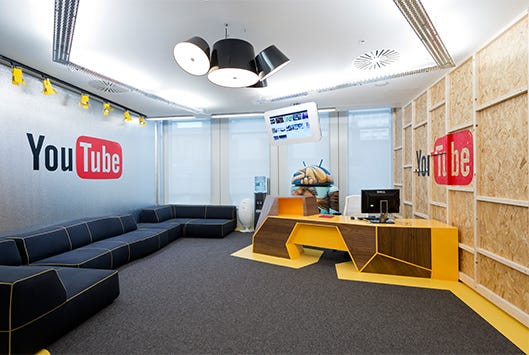What YouTube's channel changes mean for news organisations

YouTube's opened a studio space in London for partner channels to create content in. It's free to use if a channel has over 10,000 subscribers.
YouTube's been aggressively moving itself into a position where it can battle it out for TV ad spend - and the upcoming channel changes will only accelerate this.
Recently YouTube unveiled what its new channels will look like, with an emphasis on pushing a guide onto the left hand side of all pages and asking users to subscribe to channels more - and then get updates.
YouTube's realised if they are going to compete for TV ad spend they've got to show that users are engaging and watching videos for a good length of time - not just tuning in for a cat video, skipping the ad and then disappearing. Part of this is through standardising the approach to channels and trying to attract more audience to channel pages and promote them more. Interestingly the responses in the comments from YouTube's blog about changing their channel pages are not positive (generally).
I blogged last year on YouTube's strategy around funding content creation and moving to professionalise its video inventory and promote those channels which produce high quality video content - well with the new channel design this only increases.
Where does this leave news organisations on YouTube though, as they seek to expose channels with good subscriber numbers and good watch time over those with the one hit wonder videos.
The trouble for news channels on YouTube is that we're not very good at picking up subscribers and our video content is often short, sharp and to the point - not an eight minute personality driven rant at the camera style show.
Entertainment, music, make-up and spoof comedy video channels such as Barely Political (the people behind Obama Girl and The Key of Awesome) have flourished when it comes to attracting subscribers and building a fan base.
The trouble is their content lends itself to driving this subscription model of receiving content, as they can build a programming schedule around their content and be more like TV. For news organisations we produce content of the moment, and it tends to be video content to compliment a story (words, pictures etc) rather than a video package made for YouTube.
Reading the YouTube playbook you'll see content with personality, built-in YouTube hooks and a reason to come back again and again for videos about a certain topic or subject are encouraged. News channels on YouTube by their very nature tend to be about such wide and varied topics it's hard to built a narrative or expectation for users around this - at a YouTube news partner event I attended in the past week there was the example from The Telegraph of how their biggest video was a woman falling through a pavement in China and their next uploaded video was a British political update.
So how do news organisations respond to this change within YouTube? To me it seems it's a defining moment for how news organisations manage and engage with YouTube.
There is definitely a big prize on offer as YouTube becomes an attractive prospect to big spending advertisers who either repackage TV advertising or increasingly create online video creative for it - and for news organisations they have content which gets eyeballs.
The difficulty is the eyeballs tend to be short in terms of their attention span, video length and engagement.
So will news organisations need to complete re-think the type of video content produced for YouTube? The video content on the publishers site will be more video content to support the existing story while YouTube video content will favour video content that's packaged, with a narrative and with an idea someone floated last week a "YouTube news anchor" with bags of personality and that more "in your face here's the news and a webcam pressed to my face" style that's popular with Vloggers.
And will news brands have to reinvent their brands for YouTube? Will having one channel be damaging going forward, will YouTube's new focus on channels reward those who have more channels on definitive subjects e.g. politics, football etc which can be programmed and give a clearer reward to subscribers? But for each channel a news organisation adds, the higher the overhead they add as the amount of management needed for each channel increases.
We saw some examples of news channels which really are made for YouTube, the best example I saw was the ITN Truthloader project which has passed 2.5m views and has a clear brand within YouTube (aimed at using UGC footage to build video content around it and tell a story).
[youtube http://www.youtube.com/watch?v=kTkXA7N-mZg?list=PL7Vq61pMJqQCrKlguhbWt8DsaWyA8EcUE]
So, YouTube's changing, and for news organisations it's a make or break moment. If the effort is put in there is the potential for a big payback further down the track, but that reward may not be instant and with publishers under ever-increasing pressure to make digital revenues streams increase the long-term payback may be a risk not worth taking. And if the overheads of managing more channels becomes too onerous, will YouTube for news simply be too much effort with too little reward for publishers.
We'll see how it pans out in 2013 as the new YouTube channels come in and online video consumption continues to grow at a stunning pace, and whether news organisations enjoy the same growth as entertainment and other channels are seeing.
What do you think about the YouTube channel changes? Let me know in the comments below



